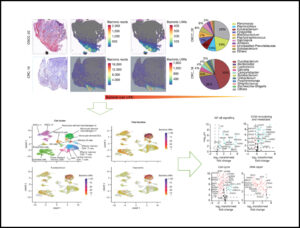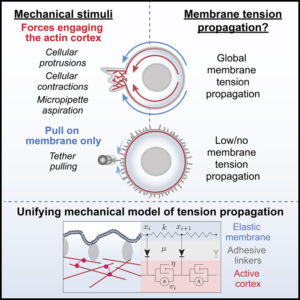octopus sleep 중 Wake-like skin patterning과 neural activity.
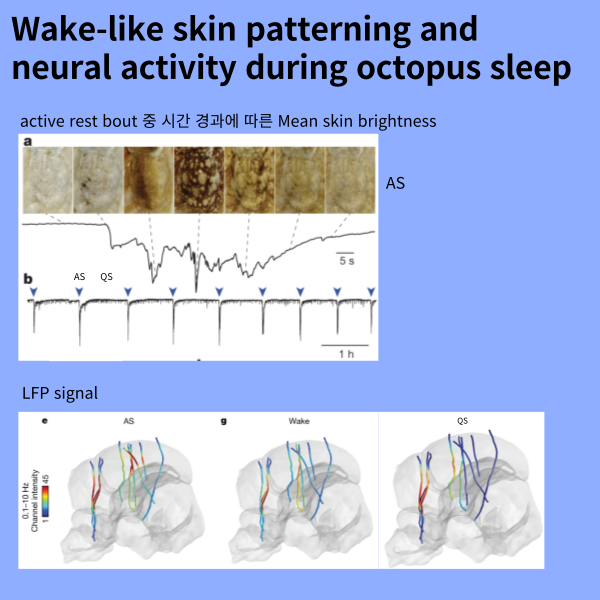
Abstract
많은 척추동물 그룹은 수면 중에 적어도 두 가지 수면 단계, 즉 rapid eye movement and slow wave sleep을 번갈아 가며 wake-like and synchronous brain activity을 각각 특징으로 합니다.
여기에서는 약 5억 5,000만 년 전에 척추동물에서 진화적으로 분화되어(참고 5) large brains과 행동의 정교함을 독립적으로 진화시킨 해양 무척추동물 octopus의 두 가지 수면 단계의 신경 및 행동 상관관계를 설명합니다. octopus의 ‘Quiet’ sleep은 약 60초 동안의 뚜렷한 신체 움직임과 skin patterning and texture의 급격한 변화에 의해 rhythmically interrupted됩니다. 우리는 이러한 bouts가 homeostatically regulated되고 빠르게 가역적이며 arousal threshold가 증가하여 뚜렷한 ‘active’ sleep stage를 나타내는 것으로 나타났습니다. active sleep skin patterning을 컴퓨터로 분석하면 octopus 전체에 걸쳐 보존되고, 깨어 있을 때와 매우 유사한 일련의 패턴을 통해 다양한 역학이 드러납니다. central brain의 High-density electrophysiological recordings에 따르면 active sleep 중 local field potential (LFP) 활동은 깨어 있을 때와 유사합니다. LFP 활동은 뇌 영역에 따라 다르며, 학습 및 기억 기능과 관련된 해부학적으로 연결된 영역인 superior frontal and vertical lobes에서 active sleep 중에 가장 강한 활동을 보입니다. quiet sleep 중에는 이 영역이 상대적으로 조용하지만 mammalian sleep spindles과 유사한 LFP 진동을 발생시키며 주파수와 지속 시간도 비슷합니다. 척추동물과의 유사성 범위는 octopus의 two-stage sleep의 측면이 복잡한 인지 기능의 수렴적 특징을 나타낼 수 있음을 나타냅니다.
Figure
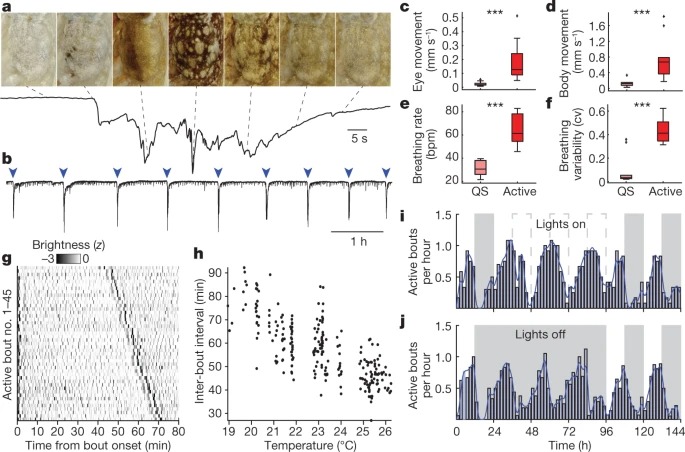
Fig. 1: octopus two-stage sleep의 Behavioural correlates.
(A) active rest bout 중 시간 경과에 따른 Mean skin brightness.
(B) 더 긴 시간대에 걸쳐 mean skin brightness를 기록하면 AS와 QS가 리드미컬하게 번갈아 나타나는 것을 알 수 있습니다.
(C-F) QS에 비해 AS bouts는 eye movements (c), body movements (d), breathing rate (분당 호흡 수)(e) 및 breathing variability (coefficient of variation) (f)이 증가하는 것을 볼 수 있습니다.
(H) Active bout inter-event interval은 온도에 따라 다릅니다.
(I, J) active bout rate의 Circadian rhythm은 3일 동안 일정한 light (i) 또는 darkness (j)이 지속됩니다.
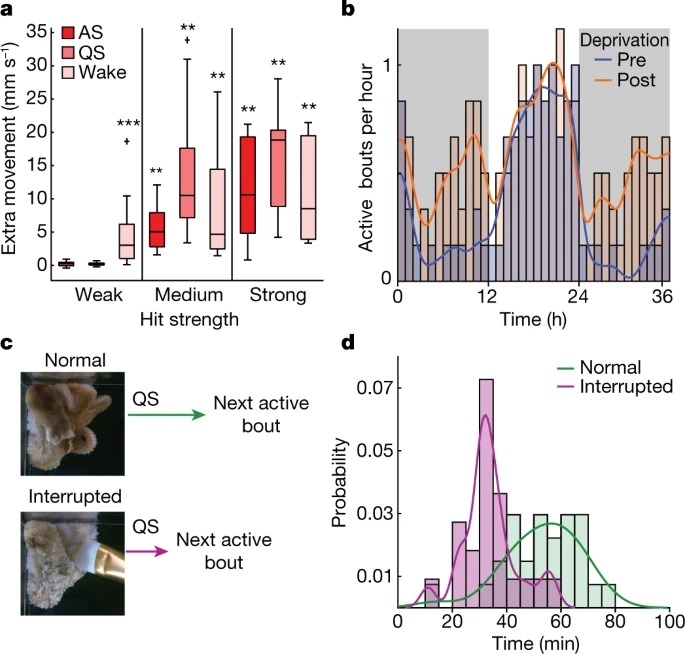
Fig. 2: sleep의 behavioural criteria 테스트.
(A) 깨어 있을 때와 비교하여 동물은 QS 및 AS bout 중에 mechanical stimulation에 대한 arousal threshold가 높아지는 것으로 나타났습니다.
(B) 2-day deprivation 후 active bout rate 증가.
(C) AS bout interruption experiment의 개략도.
(D) active bout interruption된 후 two active bouts를 분리하는 QS 기간이 짧아집니다.
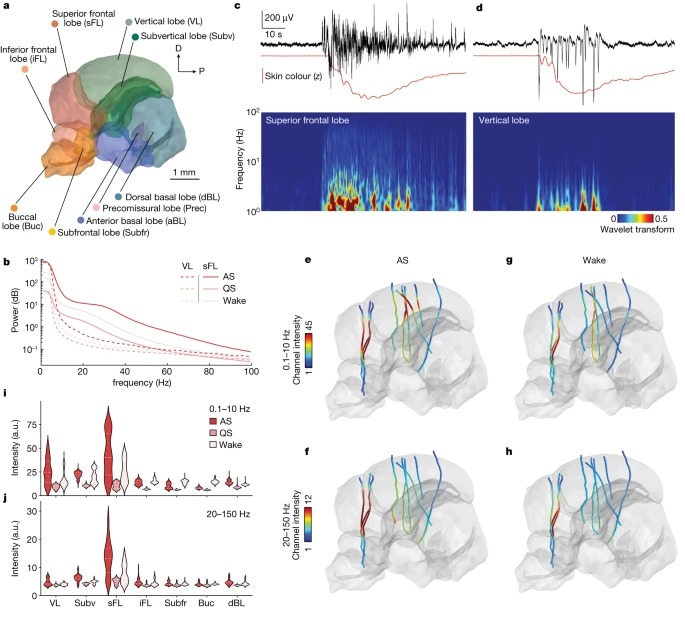
Fig. 3: AS의 Neural correlates.
(A) 모든 Neuropixels recordings이 매핑된 supra-oesophageal mass의 Atlas.
(B) sFL(실선) 및 VL(점선)에서 가져온 AS, QS 및 wake 중 LFP power spectrum.
(C, D) AS가 시작될 때 sFL(c) 및 VL(d)의 Representative LFP signals (상단 검은색 선).
(E, F), AS 중 LFP signal. 각 probe는 low (0.1-10Hz)(e) 및 high (20-150Hz)(f) frequency oscillations의 intensity에 따라 색상이 지정됩니다.
(G, H) wake phase의 LFP signal: low, 0.1-10Hz(g) 및 high, 20-150Hz(h).
(I, J) AS, QS 및 wake phase 동안의 low (i) 및 high (j) frequency oscillations의 intensity를 보여주는 Violin plots.
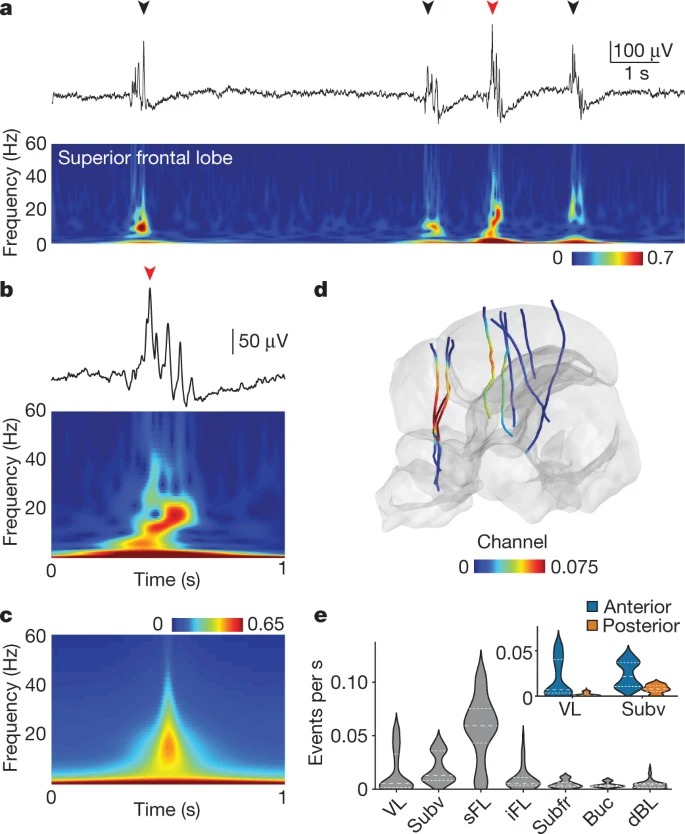
Fig. 4: QS의 Neural correlates.
(A) 위쪽은 QS 동안 sFL에 기록된 LFP를 보여 주며, oscillatory events (화살표 머리)와 다른 behavioural states에 비해 reduced activity를 보여줍니다.
(B) (a)에서 burst의 Expanded view (빨간색 화살표 머리).
(C) oscillatory events의 Average spectrogram.
(D) QS 중 oscillatory events.
(E) 각 영역의 electrodes에 대해 oscillatory event rate averaged를 보여주는 Violin plot.
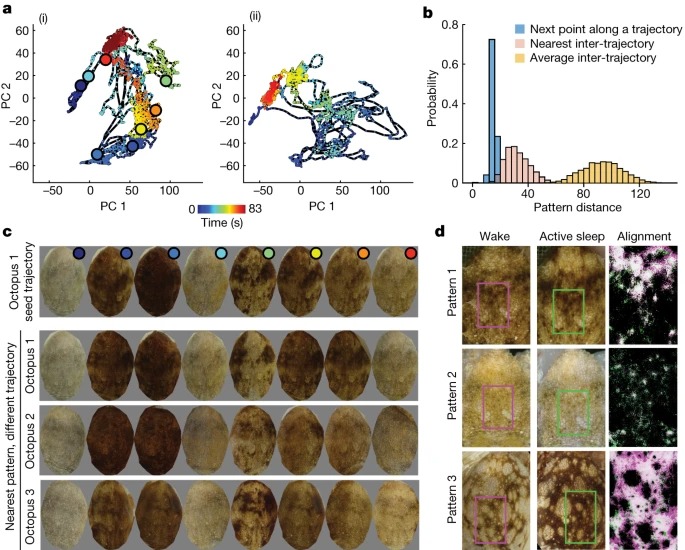
Fig. 5: AS skin patterning의 Dynamics.
(A) AS pattern space의 first two principal components로 투영된 Two example AS bout trajectories ((i) 및 (ii)).
(B) nearest points in time along a trajectory (파란색), nearest points between trajectories (분홍색) inter-trajectory distance (노란색) 궤적 간 거리의 distributions of pattern distances를 보여주는 히스토그램.
(C) top row는 a (i)의 궤적을 따라 10초 간격으로 octopus 1 skin patterns을 보여줍니다.
아래쪽 행은 octopus 1의 다른 trajectories와 다른 octopus의 경우 top seed trajectory의 각 이미지에 nearest skin patterns을 보여줍니다.
(D) similar waking and sleeping patterns의 Example pairs
Disscussion
octopus는 최소 two stages of sleep, 즉 ‘quiet’ (QS) and ‘active’ (AS)을 취합니다. Rhythmic AS bouts는 homeostatically regulated 되어있으며 temperature and lighting manipulations에 강하며, 이는 중추적으로 중요한 생물학적 현상이 활발하게 유지되고 있음을 나타냅니다. QS는 학습 및 기억과 관련된 영역(the frontal-VL system)에서 12-18Hz 진동을 보이며, frequency and duration에서 mammalian sleep spindles과 유사합니다. 그러나 QS는 뇌의 넓은 영역에 low-frequency oscillations이 나타나지 않는다는 점에서 vertebrate slow wave sleep과는 다른 것으로 보입니다. QS 동안 나타나는 brief flashes of colouration은 amplitude는 낮지만 깨어 있을 때와 유사한 신경 활동 수준을 동반합니다. 이것이 짧은 기간의 waking, micro-arousal states, 일종의 QS 또는 distinct sleep stage를 구성하는지 여부는 아직 명확하지 않습니다. AS는 eye and body twitches를 동반하는 wake-like neural activity라는 점에서 vertebrate REM sleep과 유사합니다. AS 동안에는 Coordinated postural changes (예: 팔 뻗기)가 나타나지 않으며, 이는 어느 정도의 muscular inhibition을 나타낼 수 있습니다. 그러나 anatomical homology가 부족하면 vertebrate REM sleep에서 발견되는 skeletal muscles의 atonia과의 비교가 복잡해집니다. 향후 연구에서는 이러한 유사성의 깊이를 기계적으로 조사할 예정입니다.
또한 octopus는 렘수면 중에 깨어 있을 때와 매우 유사한 일련의 피부 패턴으로 빠르게 전환합니다. 이것은 일반적으로 octopus 굴의 안전한 곳에서 발생하므로 포식자에게 위치를 알리지 않습니다. octopus는 왜 이렇게 뚜렷한 수면 행동을 할까요? 한 가지 가능성은 vertebrate motor learning 중에 발생하는 것으로 생각되는 과정과 유사하게 skin pattern control의 offline refinement를 나타내는 것일 수 있습니다. 또 다른 가능성은 rodent hippocampal replay 및 mammalian REM sleep 중 head direction system의 structured activity과 같은 memory consolidation과 관련된 vertebrate phenomena를 연상시키는, 보다 광범위하게 깨어 있는 경험의 기초가 되는 neural activity의 reactivation을 반영하는 것일 수 있습니다. AS의 기능을 완전히 규명하려면 패턴을 조작할 수 있는지 여부를 연구하고, waking skin patterns이 발현되는 행동학적 맥락을 더 잘 이해해야 합니다.
Cephalopod skin patterns은 hierarchically organized된 것으로 보이며, higher-order motor control circuitry가 large groups of chromatophores를 조정하여 macroscopic pattern elements를 생성하는 것으로 추정됩니다. AS dynamics는 이 high-level control system의 pseudo-random activation과 일치합니다. pattern activation의 통계를 연구하여 motor control elements 간의 상호 작용을 유추할 수 있습니다. 이러한 방식으로 AS dynamics는 waking skin pattern control의 논리를 이해하는 데 유용할 수 있습니다.
처음에는 인간에게서 관찰되었지만, 최근 연구에서는 많은 vertebrate species에서 two-stage sleep이 확립되었습니다. 이번 연구 결과는 cephalopods 및 arthropods의 similar active 및 QS 단계에 대한 여러 행동 보고를 보완합니다. evolutionary distances를 고려할 때 이러한 현상은 서로 독립적으로 진화했을 가능성이 높으며, complex agents가 직면한 공통 문제에 대한 수렴적 해결책을 나타낼 수 있습니다. 이러한 해결책이 실제로 존재한다면 octopus AS skin patterns의 neural activity를 high-dimensional and interpretable readout으로 판독하면 two-stage sleep의 일반적인 원리를 밝히는 데 도움이 될 수 있습니다.

